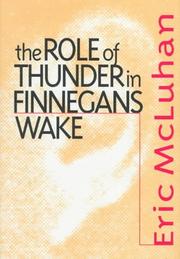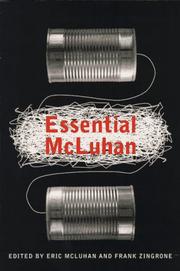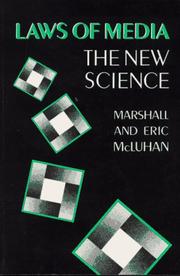| Listing 1 - 10 of 15 | << page >> |
Sort by
|

ISBN: 1282008544 9786612008542 1442682221 9781442682221 0802009239 9780802009234 Year: 1997 Publisher: Toronto, Ont. University of Toronto Press
Abstract | Keywords | Export | Availability | Bookmark
 Loading...
Loading...Choose an application
- Reference Manager
- EndNote
- RefWorks (Direct export to RefWorks)
"James Joyce's use of ten one hundred-letter words in Finnegans Wake has always been an intriguing feature of that novel. Eric McLuhan takes a new approach by placing the Wake in the tradition of Menippean satire, where language is used to shock and provoke. Seen in this light, Joyce's peculiar language and style become part of this Menippean tradition through his use of the linguistic 'thunderclap.'" "The Role of Thunder in Finnegans Wake is the first book to examine this strangest and most prominent aspect of the language of the wake, and explain its use in the context of classical Greek literature. Each thunderclap is a resonating logos that represents a transformation of human culture. McLuhan presents the thunders as encoding Joyce's study of ten major communications revolutions, ranging from neolithic technologies such as speech and fire, through cities, the railroad, and print, to radio, movies, and television. Seen in this fashion, Finnegans Wake is both an encyclopedia of the effects of technology in reshaping human culture and society, and a complete training course for detecting the changes in sensibility occasioned by new media."--Jacket.
Thunder in literature. --- Joyce, James, --- Joyce, James --- Finnegans wake. --- Finnegans wake (Joyce, James)
Book
ISBN: 9781443882996 1443882992 1443877603 9781443877602 Year: 2015 Publisher: Newcastle upon Tyne, UK Cambridge Scholars Publishing
Abstract | Keywords | Export | Availability | Bookmark
 Loading...
Loading...Choose an application
- Reference Manager
- EndNote
- RefWorks (Direct export to RefWorks)
A Menippean - Cynic - satire is a device for producing a specific kind of effect on the reader. Menippean satire is an active form, not a passive one: any work that produces the effect of a Menippean satire is a Menippean satire. It is the embodiment of a Cynic - of a Diogenes or a Menippus or a Lucian or a Rabelais. For centuries, it has frustrated the best efforts of critics to define it. Descriptive criteria (such as "a mixture of verse and prose") invariably fail because the form is determinedly fluid and polymorphous, and playful: it shifts its mode of attack with every change in culture
Satire --- Mythology --- Myths --- Legends --- Religion --- Religions --- Folklore --- Gods --- Myth --- Comic literature --- Literature --- Wit and humor --- Invective --- History.
Digital
ISBN: 9781442682221 Year: 2016 Publisher: Toronto, Ont. University of Toronto Press
Abstract | Keywords | Export | Availability | Bookmark
 Loading...
Loading...Choose an application
- Reference Manager
- EndNote
- RefWorks (Direct export to RefWorks)
Book
ISBN: 9781433112126 9781433112133 1433112132 1433112124 Year: 2011 Publisher: New York (N.Y.): Lang,
Abstract | Keywords | Export | Availability | Bookmark
 Loading...
Loading...Choose an application
- Reference Manager
- EndNote
- RefWorks (Direct export to RefWorks)
Book
Abstract | Keywords | Export | Availability | Bookmark
 Loading...
Loading...Choose an application
- Reference Manager
- EndNote
- RefWorks (Direct export to RefWorks)
ed. by Eric McLuhan and Frank Zingrone --- cultuurfilosofie --- media --- nieuwe media --- McLuhan Marshall --- communicatie --- technologie --- reclame --- pers --- kunst --- 766.01
Book
ISBN: 0802057829 Year: 1988 Publisher: Toronto, Ont. University of Toronto Press
Abstract | Keywords | Export | Availability | Bookmark
 Loading...
Loading...Choose an application
- Reference Manager
- EndNote
- RefWorks (Direct export to RefWorks)
Semiotics --- Semeiotics --- Semiology (Linguistics) --- Semantics --- Signs and symbols --- Structuralism (Literary analysis) --- 008:003 --- Semiotiek van de cultuur --- 008:003 Semiotiek van de cultuur --- 316.77 --- 316.772.2 --- Communication --- Communication, Primitive --- Mass communication --- 316.77 Communicatiesociologie --- Communicatiesociologie --- 316.772.2 Communicatiecodes, tekens, schrift, symbolen. Semiologie--(communicatiesociologie) --- Communicatiecodes, tekens, schrift, symbolen. Semiologie--(communicatiesociologie) --- Sociology --- Mass communications --- Semiotics. --- Communication.

ISBN: 0465019951 Year: 1996 Publisher: New York Basic Books
Abstract | Keywords | Export | Availability | Bookmark
 Loading...
Loading...Choose an application
- Reference Manager
- EndNote
- RefWorks (Direct export to RefWorks)
Mass media --- Médias --- McLuhan, Marshall, --- Mass media. --- Mass communications --- McLuhan, Marshall
Book
Abstract | Keywords | Export | Availability | Bookmark
 Loading...
Loading...Choose an application
- Reference Manager
- EndNote
- RefWorks (Direct export to RefWorks)

ISBN: 0802077153 9780802077158 Year: 1992 Publisher: Toronto University of Toronto Press
Abstract | Keywords | Export | Availability | Bookmark
 Loading...
Loading...Choose an application
- Reference Manager
- EndNote
- RefWorks (Direct export to RefWorks)
Before you have gone very far in this book, you will have found many familiar themes and topics. Be assured: this is not just a rehashing of old fare dished up between new covers, but a genuinely new food for thought and meditation. --Publisher.
Book
ISBN: 1725234262 Year: 2014 Publisher: Eugene, Oregon : Wipf and Stock Publishers,
Abstract | Keywords | Export | Availability | Bookmark
 Loading...
Loading...Choose an application
- Reference Manager
- EndNote
- RefWorks (Direct export to RefWorks)
Social psychology. --- Communication. --- Culture.
| Listing 1 - 10 of 15 | << page >> |
Sort by
|

 Search
Search Feedback
Feedback About UniCat
About UniCat  Help
Help News
News